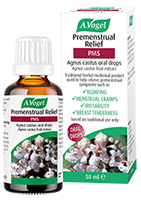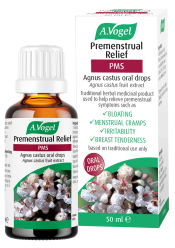What’s causing your PMS breakouts
The skin is the largest organ our bodies have and, therefore, can face a huge impact when our bodies are under stresses, or going through a hormonal change – such as your period. PMS acne usually strikes between days 22-28 of your cycle (remember day one is the day your period arrives), your oestrogen has dropped and your progesterone is at its highest monthly level.
A rise in progesterone and water retention can cause swelling of the skin, causing pores to compress shut; your skin may appear to be glowing on the surface but underneath there is a lot going on.
The progesterone rise stimulates the production of sebum – which is a thick, oily substance that naturally lubricates the skin; add that to higher testosterone levels, which activate the sebaceous glands to make even more sebum, and what you can have is the nightmare which is PMS acne.
The combination of bloating and the rise in progesterone leads to pores being blocked, making it difficult for the excess oil to escape. The result is spots, pimples, blackheads, whiteheads and acne. And it doesn’t end there. An abundance of food (sebum) gives bacteria an opportunity to increase, which in turn exacerbates inflammation.
So, now you know why you get PMS spots and acne. What, you ask, can be done to help? There are a number of solutions which are both simple and easy to achieve.
6 ways to control your PMS breakouts?
1. Water
Consuming at least 1.5 litres of plain, still water each day will go a long way to helping eliminate toxins through areas other than your skin. Remember not to stop drinking just because you feel ‘water-logged’. It’s even more important to try to cut out caffeine and fizzy drinks, as they too can affect the skin!
2. Eat a Healthy Diet
You really are what you eat! Make sure that you add fresh fruit and/or vegetables to your daily meals, and try to avoid processed foods for the entire month, not just the week of your period!
3. Get your Bowels Moving
It is vital that exit routes are open, as this enables gathered bodily toxins to leave rather than re-circulate round the bloodstream.
4. Cleaning your Skin
Use lukewarm water with a gentle cleanser and pat dry rather than rub. Cleanse after exercise or when hot, as sweat can irritate already struggling skin.
5. Make – Up
Try using water based products (they don’t block the pores as much), and try to not wear any as often as you can. If you’re in the house, stay natural!
6. Echinacea is spot on
The popular herb Echinacea is well know for its ability to boost the immune system and fight the misery of colds & flu, but did you know it can also help soothe and calm spot prone skin. Echinacea cream can be used as an everyday facial moisturiser, the ideal addition to you daily beauty regime, especially for those with sensitive skin and prone to breakouts.
Miracle cures don’t work (if you do find one, please let us know!) and these simple changes can take 2/3 months before their effects become noticeable.
I will point out that the skin can sometimes look slightly worse before it gets better. This is a good sign however as it means that your body is responding to the new regime. Skin improvements may be only a few weeks away, ladies!
And finally, if all else fails with the natural methods, go and see your doctor, as they can prescribe products – such as antibiotics- that may help too.
Do you have any tips for combating your PMS spots? Have you adapted your skin care regime to help control your monthly breakouts? I would love to hear what you do…








